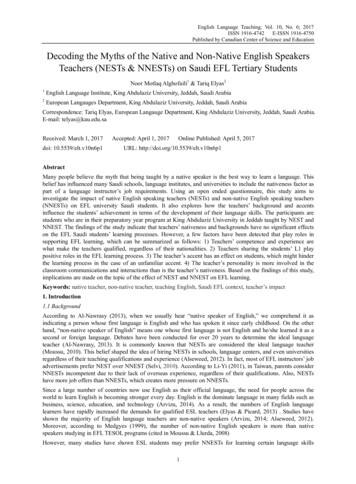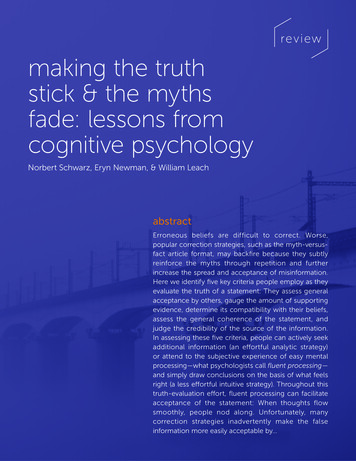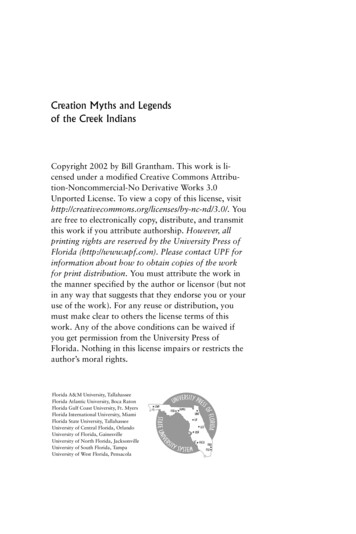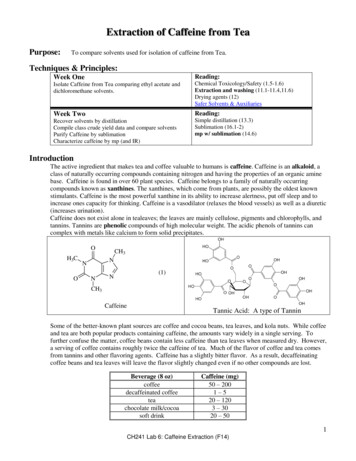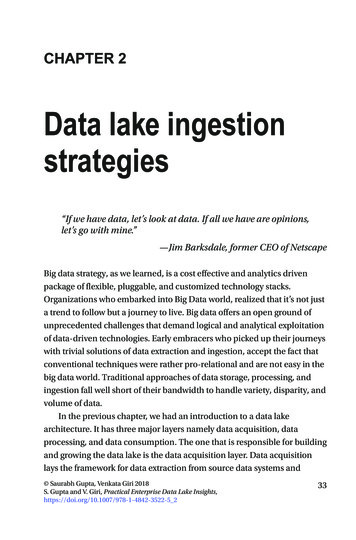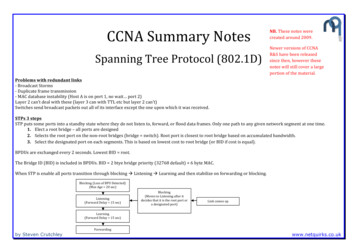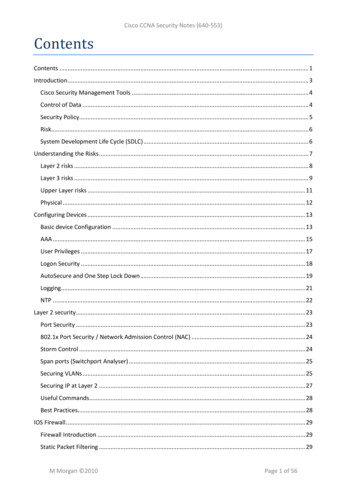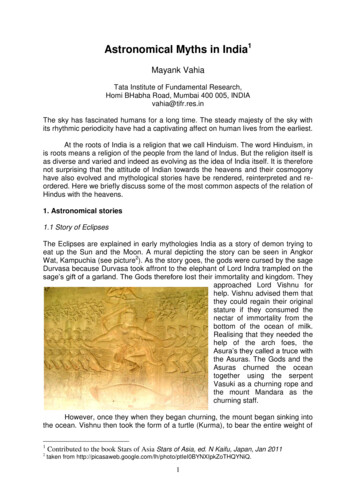
Transcription
Astronomical Myths in India1Mayank VahiaTata Institute of Fundamental Research,Homi BHabha Road, Mumbai 400 005, INDIAvahia@tifr.res.inThe sky has fascinated humans for a long time. The steady majesty of the sky withits rhythmic periodicity have had a captivating affect on human lives from the earliest.At the roots of India is a religion that we call Hinduism. The word Hinduism, inis roots means a religion of the people from the land of Indus. But the religion itself isas diverse and varied and indeed as evolving as the idea of India itself. It is thereforenot surprising that the attitude of Indian towards the heavens and their cosmogonyhave also evolved and mythological stories have be rendered, reinterpreted and reordered. Here we briefly discuss some of the most common aspects of the relation ofHindus with the heavens.1. Astronomical stories1.1 Story of EclipsesThe Eclipses are explained in early mythologies India as a story of demon trying toeat up the Sun and the Moon. A mural depicting the story can be seen in AngkorWat, Kampuchia (see picture2). As the story goes, the gods were cursed by the sageDurvasa because Durvasa took affront to the elephant of Lord Indra trampled on thesage’s gift of a garland. The Gods therefore lost their immortality and kingdom. Theyapproached Lord Vishnu forhelp. Vishnu advised them thatthey could regain their originalstature if they consumed thenectar of immortality from thebottom of the ocean of milk.Realising that they needed thehelp of the arch foes, theAsura’s they called a truce withthe Asuras. The Gods and theAsuras churned the oceantogether using the serpentVasuki as a churning rope andthe mount Mandara as thechurning staff.However, once they when they began churning, the mount began sinking intothe ocean. Vishnu then took the form of a turtle (Kurma), to bear the entire weight of1Contributed to the book Stars of Asia Stars of Asia, ed. N Kaifu, Japan, Jan 20112taken from ZoTHQYNiQ.1
the mountain. The churning continued and various objects are thrown out includingthe deadly poison Halahala. The fumes of the poison threatened to destroy theDevas and the Asuras. Lord Shiva then came to their rescue. He gathered the entirepoison in his palm and drank it. However, the poison was so potent that even Shivadare not consume it. His consort, Parvathi clasps his throat and held the poisonthere and the throat became blue with the affect of the poison. However, evenaround his neck the poison was far too hot. The therefore wrapped a snake aroundhis neck since the abdomen of a snake is cold. Hence he became known as“Neelakanta” (literally: “the blue-throated one).Eventually, the nectar of immortality came out of the Ocean, carried out byDhanvantar, the physician of the Gods. The Asuras immediately took charge of thepot. Vishnu again came to the rescue in the form of a beautiful damsel, Mohini anddistracted the Asuras. She then retrieved the potion and distributed it to the Devas.By the time the Asuras realised Vishnu’s tricks, it was too late, as the Devasregained their renowned prowess and defeatthem.When the nectar was being served tothe gods, a demon, disguised as a god, satbetween the Sun and the Moon in an attemptto procure the nectar. When he was detectedby the Sun and the Moon, Lord Visnuimmediately severed his head from his body.Unfortunately, it was not fast enough, for thedemon had already tasted a small quantity ofthe nectar and had become immortal. Eversince, this demon is said to wreak vengeanceon the Sun and Moon whenever they comenear. The head of this great demon is knownas Rahu (see figure on the left3) and his tail isknown as Ketu. However, since both have anopening on both ends, the swallowed Sunand Moon soon emerge from the demon’sbody.In Hindu astrology Rahu and Ketu areknown as two invisible planets. They areenemies of the Sun and the Moon, who atcertain times of the year (during conjunctionor opposition) swallow the Sun or the Mooncausing either a solar or a lunar eclipse.In later evolution of the myth, Rahu and Ketu are defined as the ascendingand descending nodes of the ecliptic and equator. When the Sun and the Mooncome together at these points, we get solar eclipse at ascending node and lunareclipse at descending node. Their mathematical equations are set up by the time ofArybhatta (about 500 AD) and eclipses are accurately calculated thereafter.3from British Museum, taken from Wikipedia2
1.2 Orion Myths1.2.1 Orion and the creation mythOne of the interesting aspects of Hindu mythology is that the internal ambiguity andinternal ambiguity. On the one hand, the Universe is created by a Lord who producesthe entire universe from his own thought. This Great One is later left ambiguouswhile the importance of various Gods keeps changing. In the earliest myths Indra isthe most important God and a warrior God but his significance falls in later literaturewhen the Great Trinity of Bramha (the Creator), Vishu (the Preserver) and Shiva (theDestroyer) take over. However, various other Gods and Goddesses continue tooccupy their own important roles and in fact Bramha and Vishnu are not worshippeddirectly. Bramha is not a very important God as far as number of temples etc. areconcerned and Vishnu is worshipped in the form of one of his incarnations of Ramaor Krishna. Vishnu has ten incarnations out of which the tenth one is yet to come.These are: Matsya (fish form), Kurma (Tortoise form), Varaha (boar form),Narasimha (in the form of half lion, half man), Vamana (dwarf form), Parasurama(human form), Rama (human form), Krishna (human form), Buddha (human form)and Kalki (the destroyer feminine who is yet to come). Each has a mythological storyassociated with it but we shall not deal with them here since they are not related toastronomy. However, Shiva is the only member of the Trinity who is worshippeddirectly. Shiva himself is originally worshipped as Rudra (the angry one or the onewho makes you cry). It is this Rudra form that has an interesting astronomicalassociation.In the original myth of creation, Prajapati developed a desire for his owndaughter (often called Ushas or dawn). Interestingly the mother of Ushas is neverdefined. But because this relation of incestuous, the other Gods were appalled. Theyapproached Rudra or Shiva to prevent this incest from occurring. On the other hand,Usha herself, embarrassed by this attention kept changing her form but each timePrajapati also took the equivalent male form out of his desire for her. It is one ofthese forms, when Prajapati is an antelope that is reflected in the sky in the form ofOrion-Taurus. Prajapati is Taurus. The deer or the deer's head is the modernconstellation, Capricorn. Sirius was the deer piercer who shot the arrow. Orion, thehunter with bow and arrow is Rudra trying to stop him from this sin. In variants ofthis, the seed of the father falls on the ground with other consequences and thereare other elaborate stories about the anger of Rudra which we shall not discusshere.In some variants of this story, The brightest star in Taurus, Aldeberan,(Rohini) and represents the female deer, Prajapati is represents Orion, and the threestars that form belt of Orion, are the arrow that pierced him. The arrow is Agni (fire),Soma (a celestial drink or Moon), and Vishnu (the supreme god) Agni was the firegod. Sirius and Aldeberan represent the deer piercer.1.2.2 Skanda and the MahabharataIn the Mahabharata, a later epic and the major Hindu epic, Orion was the warrior,Skanda. Skanda was the six headed son of Shiva. He was both the god of war andthe General of the gods. Riding a red crested cock and blowing fearful sounds on a3
conch-shell, he thrust his spear into the White Mountain. The top split off into the skybecoming the Milky Way. The hero also killed various demons and restored peace.1.2.3 Orion and the doveIn another version of the story, Orion is a hunter who is waiting on top of a treewaiting for a hunt when he sees a beautiful dear. As he aims is arrow at the dear, thedear pleads with him that while she is a legitimate catch of the hunter, she has asmall baby at home and the dear would be grateful if he gave the dear a chance tomeet its baby one last time before its death. The hunter lets her go, not expectingher to return. However, while sitting on the tree, unwittingly he keeps taking leavesfrom the Bilva tree and dropping them on the ground where there is a small ShivaLinga. The bilva leaves are particularly precious to Shiva who is pleased with thisworship. The dear however keeps its word and returns to die on the arrow of thehunter. Touched by this scene of valour, decency and commitment to honesty, Shivatransfers them to the heavens as Orion and Taurus.1.3 Ursa Major and PleiadesIn Indian mythology, the seven central stars of Ursa Major that form the cup shape,is refered to as Saptarshi meaning seven (sapta) sages (rishis). These are Vasistha,Bharadvaja, Jamadagni, Gautama, Atri, Visvamitra and Agastya. These seven Rishisare often mentioned in the later works as typical representatives of the character andspirit of the pre-historic or mythical period. Their astronomical designations are givenin the table below.Indian ayer Designation Western Nameα UMaDubheβ UMaMerakγ UMaPhecdaδ UMaMegrezε UMaAliothδ UMaMizarε UMaAlkaidHowever, Agni developed a desire for the wives and wanted to seduce them.On the other hand a minor goddess or a nymph (depending on who you ask) wantedto marry Agni. She therefore took the form of six of the seven wives of theSaptarshi’s and mated with Agni. However, the Saptarshi’s themselves uncertainabout the chastity of their wives, divorced them and they went on to become theKritika or Pleiades. Only one wife Arundhati of Vasishta remained loyal to herhusband that is the binary in Ursa Major.In other variations, Kritika or Pleiades are seven in number and not related toSaptarshi at all. They are the mothers of Kartikeya who is sometimes mentioned asone of the two sons of Shiva but there are other suggestions including Kartikeyabeing the son born of Agni and and Swaha who brought up the five daughters andhence together they were called Kritikas.4
1.4. Pole StarThe pole star is called Dhruva in Hindu mythology. Dhruva was born a son of theKing Uttānapāda and his wife Suniti (or Sunrita). The king also had another sonUttama, born to his second queen Suruchi, who was theKing’s favourite wife. Once,when Dhruva was five years of age, the two princes playfully raced towards theirfather's lap. But, the Suruchi chided Dhruva and insulted him for trying to woo theattention of his father since he was not her son. She further asked him to redeemhimself by seeking Vishnu's blessings.Suniti consoled the distraught child, by asking him to ignore Suruchi's andmeditate on the Lord. Dhruva started his penance, and went without food and waterfor six months, his mind fixed on the Lord. Pleased with his austerity, the LordVishnu appeared before him. Seeing the Lord before him, he prostrated himselfbefore the Lord.When Vishnu was pleased with Dhruva's austerity and asked him to ask for aboon. Dhruva said that that he did not know how to sing the praise of Lord Vishnu,and therefore asked the boon of knowledge. Pleased with this, the Lord Vishnu toldhim that he would be Great and wise King on Earth and on his death he will beimmortalised with the most revered seat of Pole Star to this six year old child. TheSaptarshis also point remain close to and associated with the location of Dhruva.2. CosmogonyIn its earliest format, the Vedic Hinduism is a tripartite relation between Humans,Gods and Ancestors. The most prominent deities of the Vedic Hinduism are Indra(Heroic God of bravery and valour) Agni (fire), Soma (ritual drink) , Vishvadevas(Gods of all the worlds), Asvins (Gods’ horsemen, Varuna (sky, water and celestialocean), Maruts (Storm God), Mitra (patron divinity of honesty, friendship, contractsand meetings), Ushas (Dawn). These are essentially abstract gods and are residentof the earth or connected to it directly in terms of their manifestation. They do notrefer directly to heavens. In that sense, the earliest form of Vedic Hinduism is morefocused on the earthly reality.One of the most conspicuous aspects of Hindu Cosmogony is the concept ofTime. While the original concept begins with 12 months and luni solar calendar, soonit expands. In the oldest Indian document Rig Veda dated between 2000 and 1500BC, the concept is of a year of 360 days of 12 months with two intercalary monthsevery 5 years to synchronise Solar and Lunar calendars. However, in later literature,the concept of Yuga is expanded significantly and it takes the form of 4 distinctYugas that make 1 day of Brahma in a cycle that is repeated for several Mahayugas.In this the 4 yugas are, Krita Yuga of the duration of 1,728,000 years, Treta Yuga of1,296,000 years duration, Dvapara Yuga of 864,000 duration and the current KaliYuga of 432,000 year duration.We site one example in the leap of their imagination. It called Nasadiya Suktaand it can be translated as follows:1. At first was neither Being nor Non-being.5
There was not air nor yet sky beyond.What was its wrapping? Where? In whose protection?Was water there, unfathomable and deep?2. There was no death then, nor yet deathlessness;of night or day there was not any sign.The One breathed without breath, by its own impulse.Other then that was nothing else at all.3 Darkness was there, all wrapped around in darkness,And all was water indiscriminate: ThenThat which was hidden by the Void, that One, emerging,Stirring, through power of Ardor, came to be.4. In the beginning Love arose,Which was the primal germ cell of the mind.The Seers, searching in their hearts with wisdom,Discovered the connection of Beings with Nonbeing.5. A crosswire line cut Being from Nonbeing.What was described above it, what below?B
In Hindu astrology Rahu and Ketu are known as two invisible planets. They are enemies of the Sun and the Moon, who at certain times of the year (during conjunction or opposition) swallow the Sun or the Moon causing either a solar or a lunar eclipse. In later evolution of the myth, Rahu and Ketu are defined as the ascending

